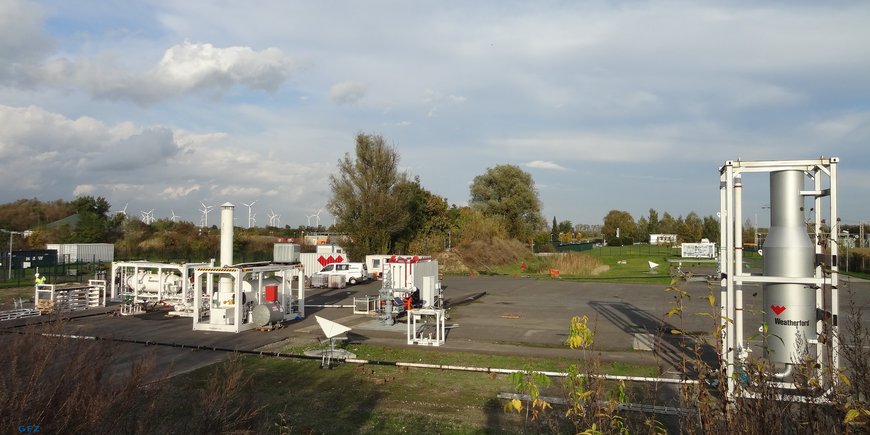First results of the experiment from the geological CO2 storage site
04.11.2014: On October 27th, the GFZ German Research Center for Geosciences successfully finished its field experiment on the back production of carbon dioxide (CO2) at its pilot site for research on the geological storage of the greenhouse gas CO2 at Ketzin/Havel, Federal State of Brandenburg. Over 13 days 240 t of CO2 and 57 m3 fluid have been safely and smoothly back produced from the reservoir.
Initially, it was planned to back produce around 500 to 1,000 t of CO2. However, due to the very smooth back-production during the first week, the researchers were able to run an alternating load regime with back-production during daytime and shut-in during night-time. “This provided the scientific opportunity to study how the reservoir and the wellbore respond to such an alternating load”, explains Axel Liebscher, Head of the Center for Geological Storage at the GFZ. “During the final phase of the experiment, we also stepwise reduced the back-production rate to determine, below which back production rate the co-production of formation fluid, i.e. water from the reservoir, ceases. This offers valuable clues to the dynamic conditions within the wellbore.”
Between June 2008 and August 2013, a total amount of around 67,000 t of CO2 has been injected into porous sandstone at 630 to 650 m depth at the Ketzin pilot site. The field experiment aimed at studying three main questions: What is the behaviour of the reservoir and the wellbore during back production of CO2? What is the chemical composition of the back produced CO2 and the co-produced formation fluid? What is the surface spreading of the back produced CO2? “The gained results will give information on the dynamic of the reservoir and on the question whether a CO2 back-production is a suitable measure for pressure reduction in the reservoir in case of unintended pressure evolution in the storage system. In addition, they will help to better understand and assess potential wellbore leakages and the accompanying risks”, Axel Liebscher says. The measured compositions of back produced CO2 and formation fluid will allow study the geochemical interactions between CO2, formation fluid and rocks under real in-situ conditions. First results indicate that the back produced CO2 has a purity of more than 98%. Most important impurity is nitrogen N2 with less than 2% in the CO2 stream. The nitrogen most probably comes from a CO2-N2 co-injection experiment performed in summer 2013 at the end of the injection. The results will help to verify the informational value of geochemical lab experiments, which are typically performed in simplified synthetic systems.
The feasibility of CO2 back-production and the knowledge about the composition of the back produced CO2 are also important for the assessment of a potential use of the stored CO2. The successful field experiment indicates that a safe back production of CO2 is generally feasible and can be performed at both, stable reservoir and especially wellbore conditions. The results gained at the Ketzin site refer to the pilot scale. Upscaling of the results to industrial scale is possible but must first be tested and validated at so-called demo projects. With the back-production test new knowledge on fundamental processes were gained, which allow for such a transfer to bigger scale.
More information about the Ketzin project, see website: www.co2ketzin.de








![[Translate to English:] Torsten Sachs in front of a climate station on a field](/fileadmin/_processed_/3/9/csm__TorstenSachs_bearbeitet_GS_4a1365ef84.jpeg)

![[Translate to English:] left image flood at the Ahrtal: image from above, several houses are flooded; left image:: Heidi Kreibich;](/fileadmin/_processed_/4/4/csm_Bild2_9af0130e9f.png)



![[Translate to English:] Start der Vega Rakete](/fileadmin/_processed_/6/4/csm_20231201-kachel_Vega-VV23-launch_ESA-CNES-Arianespace_706716b68c.jpeg)









![[Translate to English:] Poster exhibition at the Brandenburg Hydrogen Day at the GFZ, some participants in the foreground](/fileadmin/_processed_/6/5/csm_Erster_Brandenburgischer_Wasserstofftag_GFZ_402fcec95e.jpeg)
![[Translate to English:] Group picture of the participants](/fileadmin/_processed_/9/4/csm_20231108_CAWa-Workshop-Tashkent_Gruppenbild_99ea779d8a.jpeg)

![[Translate to English:] [Translate to English:] Hörsaal](/fileadmin/_processed_/e/6/csm_H%C3%B6rsal_e21ac645fb.jpeg)


![[Translate to English:] The Delegations in the Historic Library on the Telegrafenberg. In the back there are from left to right, the Dutch Ambassador for Germany, Ronald van Roeden, the Dutch Minister for Education, Culture and Science, Robbert Dijkgraaf and the scientific director of the GFZ, Susanne Buiter.](/fileadmin/_processed_/d/b/csm_Kachel-2_9eba4b4212.jpeg)

